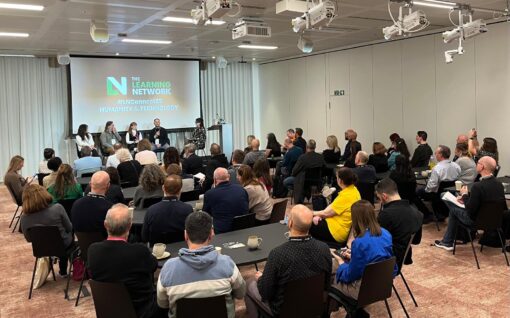Out of adversity comes opportunity
Insights Media’s head of content, Roisin Woolnough, reflects on some of the changes that impacted on learning professionals in 2020 and what they mean for the year ahead.
Like everyone else, I was very glad to see the back of 2020. Very glad indeed. Although I didn’t suffer any personal losses or hardships or any interruption to work, for which I am very grateful, it was undeniably a difficult and challenging year.
 But, challenge can be a good thing and not everything about 2020 was bad. Out of challenge comes opportunity. Or, as Benjamin Franklin, the American polymath and one of the founding fathers of the US, so famously said: “Out of adversity comes opportunity”.
But, challenge can be a good thing and not everything about 2020 was bad. Out of challenge comes opportunity. Or, as Benjamin Franklin, the American polymath and one of the founding fathers of the US, so famously said: “Out of adversity comes opportunity”.
Tsunami of change
There was most definitely an abundance of opportunity for learning professionals last year, helping organisations and individuals navigate their way through the tsunami of change. The landscape of work changed overnight, with Covid-19 and lockdown restrictions precipitating seismic changes in how and where we work and how and where we learn.
L&D had a vital role to play in supporting organisations and individuals through these changes. And it will continue to have a vital role to play in the coming months as we move through the next stages of the pandemic and as skills, roles, organisations and working patterns continue to evolve.
It is important to reflect back on the changes of 2020, acknowledge them and think about what they mean going forward in 2021 and beyond.
Digital transformation
Finally, finally, after years of talking about it and countless reports predicting it, the digital revolution actually happened. And like many revolutions, when it came, it came very quickly. Digitisation was turbocharged, with operations going digital and entire workforces switching to remote working in a remarkably short space of time.
At last, organisations (and L&D) were forced to abandon their allegiance to face-to-face learning and embrace the world of virtual learning. And bar a few teething problems here and there, organisations found that it wasn’t so bad after all. It could be done. It worked. People learnt what they needed to learn and the wheels of work kept turning.
As a result, learning is no longer about the delivery of face-to-face training programmes, but about responding to immediate needs – helping people learn what they need to know in order to do their job, when they need to learn it. This is something we have been talking about in the L&D profession for a very long time – learning at the point of need. Ta-da!
The digital tools were already there – people just had to learn how to use them and then keep using them as their default option. L&Ders played its part – creating and curating resources, signposting people to the right places and helping embed new ways of working, but the hardest hurdle was always going to be cultural change. Now that the cultural change has happened, there’s no turning back. That’s why Covid-19 brought digital transformation on apace – for many people and organisations it was a case of sink or swim and so naturally, people swam.
The home working revolution
Of course, face-to-face learning will return again, when the situation permits. But, never on the scale as before. We won’t all stay digital workers forever either. Not all the time, anyway. But, the pendulum has definitely swung in favour of remote working. There have been so many pieces of research recently that show how well it works and how popular it has been. For example, What 800 executives envision for the postpandemic workforce, a report by McKinsey Global Institute from September 2020, https://www.mckinsey.com/featured-insights/future-of-work/what-800-executives-envision-for-the-postpandemic-workforce?cid=other-eml-alt-mip-mck&hdpid=8047f6a6-c693-4786-bc58-4cbceb97474d&hctky=12208148&hlkid=2eaff5295ffc4c57b7537886180bfd4f#, found that 20% of UK executives say at least one-tenth of their workforce could work remotely for two or three more days a week in the future. Only this week, Unilever, one of the UK’s biggest companies, said it will never go back to traditional, pre-Covid working patterns. As reported in The Guardian (https://www.theguardian.com/business/2021/jan/13/unilever-workers-will-never-return-to-desks-full-time-says-boss), Unilever will take a hybrid approach, enabling employees to do a mix of office work and home work.
That’s the executive view. Workers are even more keen on the home working revolution. More than 9,000 knowledge workers were surveyed last year by the software company Slack for its global report Moving beyond report: Workplace transformation in the wake of Covid-19 (https://slack.com/intl/en-gb/blog/collaboration/workplace-transformation-in-the-wake-of-covid-19), with 72% of them saying they would like a mix of remote and office work. They cited higher levels of satisfaction when working remotely, increased productivity, a better work-life balance and reduced levels of stress and anxiety.
Self directed learning
Another interesting trend that became apparent last year during the first lockdown was that employees are very good at seeking out information when they have a need. Rather than employers and learning professionals dictating who learnt what, when and why, it was employees who drove the learning agenda. When they wanted information on Covid-19, they looked for it and found it. When they needed to find out how to use Zoom to conduct meetings, they looked for information and they found it. And a lot wanted to know more about how to maintain physical, emotional and mental wellbeing during the pandemic and again, were very able to find the resources they needed.
This confirmed what many people in L&D already knew and were already moving towards – making resources readily available and signposting to them. It’s about enabling and facilitating learning, not owning it.
So, L&D has demonstrated real value during these past few months, helping people and organisations access the information and resources they needed, quickly and at scale. This is a tremendous achievement. Employees also demonstrated great resourcefulness and resilience. They showed that they could be trusted to get on with their jobs and maintain productivity, while working at home and potentially juggling childcare and homeschooling.
There is a lot that learning professionals, employers and employees can learn from the experiences of 2020. Some of the changes will be long lasting and need to be refined and bedded in. And most likely, there will be more change yet.

